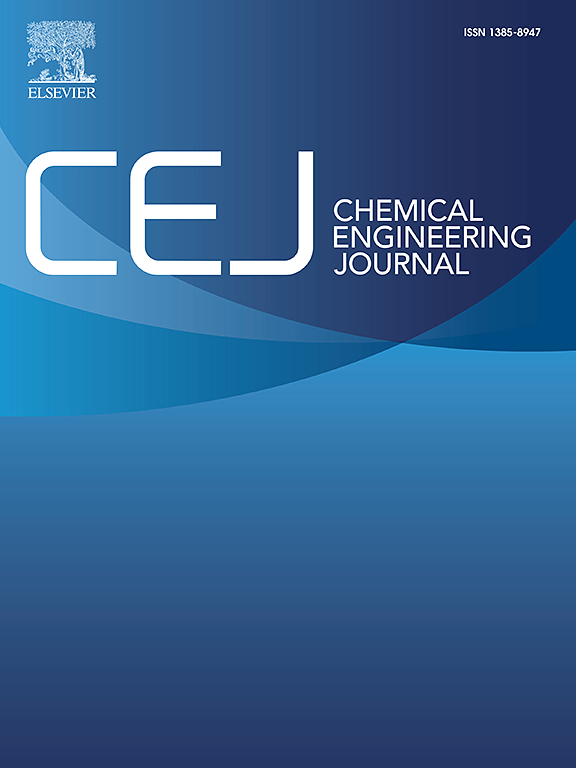Iron-carbon amendment enhanced pollutant removal and greenhouse gas reduction in constructed wetlands under PFBA stress
IF 13.2
1区 工程技术
Q1 ENGINEERING, CHEMICAL
引用次数: 0
Abstract
Biochar and iron-carbon (Fe-C) are widely used as amendments in constructed wetlands (CWs), whereas their impacts on greenhouse gas (GHG) emissions are rarely explored under perfluorobutanoic acid (PFBA) stress. Thus, this study established bamboo biochar and Fe-C amended CWs (CW-BC and CW-IC) to investigate pollutant removal and GHG reduction with PFBA addition. The results indicated that the removal efficiencies of COD, NH4+-N, TN, TP, and PFBA in CW-IC increased by 13.27 %, 11.69 %, 28.66 %, 14.36 %, and 4.34 %, respectively, compared with those in CW-BC. PFBA increased CH4 and N2O fluxes in CWs, while CW-IC exhibited better resistance to PFBA stress compared to CW-BC. The mean CH4, CO2, and N2O fluxes in CW-IC were 0.53 ± 0.32, 148.93 ± 25.86, 0.10 ± 0.04 mg·m−2·h−1, significantly lower than those in CW-BC at 100 μg/L PFBA (p < 0.05). Fe-C could reduce the global warming potential (GWP) in CWs by 68.96 %, whereas biochar only achieved an 18.68 % reduction. This was attributed to the iron cycle enhancing the abundances of nitrifiers (e.g., Ellin6067, Candidatus Nitrotoga), denitrifying bacteria (e.g., Geobacter, Denitratisoma, Thauera), and stimulating the expression of AOB amoA, nirK, nirS, and nosZ genes to reduce N2O emissions. Moreover, Fe-C addition inhibited mcrA gene expression and promoted Fe(III)-dependent anaerobic oxidation of methane to reduce CH4 production. This study demonstrates that Fe-C outperforms in resisting PFBA and reducing GHG, providing a theoretical basis for optimizing filler amendments to improve the environmental benefits of CWs.

铁碳修正增强了PFBA胁迫下人工湿地的污染物去除和温室气体减排
生物炭和铁碳(Fe-C)被广泛用作人工湿地(CWs)的改化剂,但在全氟丁酸(PFBA)胁迫下,它们对温室气体(GHG)排放的影响很少被研究。因此,本研究建立了竹炭和Fe-C改性的CWs (CW-BC和CW-IC),研究添加PFBA对污染物的去除和温室气体的减少。结果表明,与CW-BC相比,CW-IC对COD、NH4+-N、TN、TP和PFBA的去除率分别提高了13.27 %、11.69 %、28.66 %、14.36 %和4.34 %。PFBA增加了CWs中CH4和N2O的通量,而CW-IC对PFBA胁迫的抗性优于CW-BC。平均甲烷、二氧化碳和一氧化二氮通量在CW-IC 0.53 ± 0.32,148.93 ± 25.86,0.10 ±0.04 mg·m−2·h−1,显著低于CW-BC 100 μg / L PFBA (p & lt; 0.05)。Fe-C可使CWs的全球变暖潜势(GWP)降低68.96 %,而生物炭仅能降低18.68 %。这是由于铁循环增强了硝化菌(如Ellin6067、Candidatus Nitrotoga)和反硝化菌(如Geobacter、Denitratisoma、Thauera)的丰度,并刺激了AOB、amoA、nirK、nirS和nosZ基因的表达,从而减少了N2O的排放。此外,Fe- c的加入抑制了mcrA基因的表达,促进了Fe(III)依赖性甲烷的厌氧氧化,从而减少了CH4的产生。该研究表明,Fe-C在抗PFBA和减少温室气体方面表现优异,为优化填料改性以提高化学废物的环境效益提供了理论依据。
本文章由计算机程序翻译,如有差异,请以英文原文为准。
求助全文
约1分钟内获得全文
求助全文
来源期刊

Chemical Engineering Journal
工程技术-工程:化工
CiteScore
21.70
自引率
9.30%
发文量
6781
审稿时长
2.4 months
期刊介绍:
The Chemical Engineering Journal is an international research journal that invites contributions of original and novel fundamental research. It aims to provide an international platform for presenting original fundamental research, interpretative reviews, and discussions on new developments in chemical engineering. The journal welcomes papers that describe novel theory and its practical application, as well as those that demonstrate the transfer of techniques from other disciplines. It also welcomes reports on carefully conducted experimental work that is soundly interpreted. The main focus of the journal is on original and rigorous research results that have broad significance. The Catalysis section within the Chemical Engineering Journal focuses specifically on Experimental and Theoretical studies in the fields of heterogeneous catalysis, molecular catalysis, and biocatalysis. These studies have industrial impact on various sectors such as chemicals, energy, materials, foods, healthcare, and environmental protection.
 求助内容:
求助内容: 应助结果提醒方式:
应助结果提醒方式:


